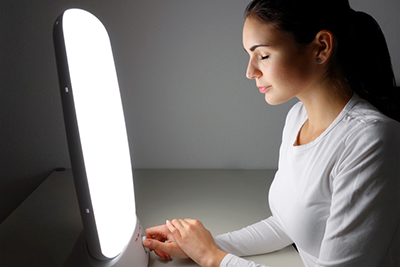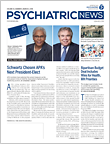While it has been known for decades that patients with clinical depression often report feeling better after staying up all night, psychiatrists do not routinely prescribe sleep deprivation as a treatment. In recent years, however, European psychiatrists have begun to explore an approach that manipulates the sleep-wake cycle, known as chronotherapy, as a possible treatment for mood disorders.
In the United States chronotherapy is used to treat some types of sleep disorders, but few facilities offer this treatment for mood disorders, including seasonal affective disorders. Chicago Psychiatry Associates (CPA) is one of these clinics, where a regimen called triple chronotherapy is used. The therapy consists of three components: wake therapy, bright light treatment, and sleep phase advancement.
A striking feature of chronotherapy is the rapid relief of mood symptoms. “We see patients feel better within 12 to 36 hours after the treatment,” John Gottlieb, M.D., the medical director of CPA, told Psychiatric News. He is also a clinical assistant professor of psychiatry at the Feinberg School of Medicine at Northwestern University.
Wake therapy, also known as sleep deprivation or sleep restriction, has been
shown to induce fast response in approximately half of patients with major depression. However, most patients tend to relapse after they return to their usual sleep schedules. Separately,
bright light therapy is an effective treatment for major depression with or without seasonal patterns.
Sleep phase advance refers to moving a patient’s sleep hours to an earlier schedule. Most patients with depression have delayed sleep schedule (they have difficulty falling asleep until very late at night or their sleep hours become later and later). With the help of wake therapy, bedtime can be shifted earlier in the night without accompanying insomnia.
A Combination of Rapid and Lasting Response
In the 1990s, researchers including Francesco Benedetti, M.D., and Anna Wirz-Justice, Ph.D., developed a treatment that combines wake therapy, bright light treatment, and sleep phase advance. This combination can extend the rapid efficacy of wake therapy to persistent response or remission in patients with major depression or bipolar depression after as little as one course of treatment.
The triple chronotherapy regimen at CPA takes three and a half days to complete. On the first day, the patient is kept awake all night. On the second day, the patient stays awake all day and sleeps from 6 p.m. to 1 a.m. On the third and fourth days, the patient sleeps from 8 p.m. to 3 a.m. and then again from 10 p.m. to 5 a.m. Between days 2 and 4 of treatment, the patient receives 30 minutes of bright light therapy every morning.
Like all treatments for mood disorders, not all patients respond to chronotherapy, but many are able to achieve response and remission. Some patients require continued medications, but some do not, according to Gottlieb.
In a
randomized, controlled study conducted by Danish researchers, 61.9 percent of patients with major depression remained in remission 20 weeks after receiving three courses of chronotherapy that included a series of chronotherapeutic interventions similar to the algorithm recommended by Benedetti and Wirtz-Justice and practiced at CPA. The remission rate was statistically significantly higher than the remission rate of 37.9 percent in the control group, who were given a daily exercise regimen. The experimental group also had a significantly larger improvement in depression symptoms, measured by the Hamilton Depression Rating Scale (HAM-D).
Resetting Circadian Rhythm May Lift Mood
While the mechanism behind the therapeutic effect of chronotherapy is unknown, scientists suspect that circadian rhythm is inextricably linked to mood regulation in the brain.
Studies have shown that the association between sleep cycle disturbance and mood disorders is bidirectional; in other words, each can cause or worsen the other. About two-thirds of patients during a major depressive episode
report insomnia and about 15 percent report hypersomnia. In addition,
sleep disturbance is a well-established characteristic of bipolar disorder and is associated with suicidal behavior in people with mental illness. Additionally, nearly half of those with
delayed sleep phase syndrome (DSPS), in which a patient goes to sleep and wakes up much later than normal schedules, also suffer from depression. For the treatment of DSPS, both sleep phase advancement and bright light treatment are often used.
At the University of California, San Diego (UCSD), Barbara Parry, M.D., a professor of psychiatry, is conducting clinical studies on the effectiveness of chronotherapy for treating patients with depressive disorders. Participants in Parry’s studies are women who are experiencing pregnancy and postpartum depression, premenstrual dysphoric disorder (PMDD), and menopausal depression. Parry is not only measuring the efficacy of chronotherapy but also investigating how and why it works. The mechanism, she believes, has to do with manipulating melatonin levels.
In healthy people, melatonin concentration in blood, secreted by the pineal gland in the brain, rises sharply in the evening, reaches the peak at bedtime, and drops to near zero in the morning and during the day. The cyclic change in melatonin release, aligned with sunrise and sunset, is the physiological drive of the sleep-wake cycle. This cycle is disturbed in patients with sleep disorders as well as many with depression, Parry told Psychiatric News.
“In patients with depression, the timing of melatonin levels is disturbed,” she said. “But after the [chronotherapy] treatment, the melatonin levels are normalized.”
“We can think of disturbed circadian rhythm like arrhythmia, where the timing of nerve signaling and heart contraction are misaligned,” Parry explained. “The chronotherapy works like a pacemaker that resets the system and realigns the rhythm, which seems to lead to mood improvement.”
Not a DIY Treatment
The chronotherapy regimen used at UCSD is somewhat different from that at CPA. Patients at UCSD go through half a night of sleep deprivation and one to two weeks of bright light treatment every morning, while skipping the sleep phase advancement. The sleep phase adjustment was dropped for practicality, according to Parry, as most patients find it difficult to fit in an early-evening bedtime at home in these outpatient studies.
Parry noted that this modified treatment appears to be able to induce acute mood improvements that are sustained over months after one course of chronotherapy. The duration of the antidepressant response is under investigation. She and colleagues also found that a continuous wake period (no napping allowed) for only half a night, depending on individual patient’s sleep cycle disturbance, may be sufficient to induce the antidepressant effect.
“Individuals who are phase-delayed are best treated by advancing sleep, whereas individuals who are phase-advanced are best treated by delaying sleep,” said Parry. She noted that, although most patients have delayed sleep phase, pregnant women often have advanced phase, or earlier-than-normal sleep cycles. According to her protocol, phase-delayed patients are kept awake only between 3 a.m. and 7 a.m., while phase-advanced patients are kept awake only between 11 p.m. and 3 a.m.
At CPA, the triple chronotherapy regimen used to be administered in a semi-sequestered setting under staff supervision. Now, “this is a selfadministered, home-based, virtually-monitored treatment,” said Gottlieb. After initial evaluation and education, patients are given a schedule and detailed instructions on how to stay awake all night, when to get bright light treatment, and when to sleep, with regular online contacts with the clinic staff, he explained.
Despite the apparent simplicity of chronotherapy, both Gottlieb and Parry cautioned that this is not a do-it-yourself treatment that patients should undertake without the care and guidance of trained mental health professionals.
“One big concern is the risk of inducing mania or hypomania in bipolar patients,” said Gottlieb. “That’s why we require patients with bipolar depression to be on a mood stabilizer, preferably lithium, before getting chronotherapy.”
Other precautions need to be taken with chronotherapy. Some patients are also required to temporarily stop concurrent medications that affect sleep. Appropriate equipment, such as a light box of 10,000 lux brightness and blue-blocking glasses, is also needed.
Chronotherapy May Present Welcome Alternative for Some Patients
The rapid effectiveness of chronotherapy may have implications for acutely suicidal patients. In a
small pilot study at Medical University of South Carolina, 10 suicidal patients with unipolar depression went through a course of triple chronotherapy. On the day after the treatment, the patients’ HAM-D mean score decreased from 24.7 to 8.4. The Columbia Suicide Severity Rating Scale (CSSRS) mean score decreased from 19.5 to 7.2.
In addition, chronotherapy may be a valuable alternative to antidepressants for patients who cannot or prefer not to take medications, including pregnant women.
Although well established for treating sleep disorders, chronotherapy is little known and even less practiced as a treatment for depression in the United States. “It’s more commonly used in Scandinavia, Italy, Germany, the Netherlands, and other countries, for various reasons. It does not have the kind of funding and financial backing for research and promotion [compared with pharmaceuticals],” said Gottlieb. A couple of clinical trials of chronotherapy, in addition to Parry’s, are currently listed on ClinicalTrials.gov. As new evidence accumulates, the role of chronotherapy among all options for mood disorders may eventually be clarified. ■

